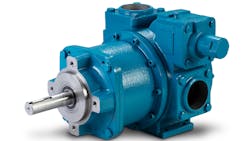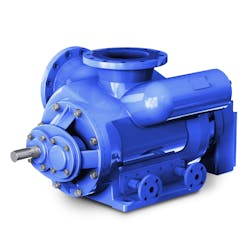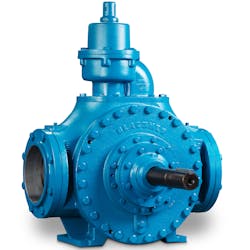There are philosophical choices that have sparked some of the great debates of our time: Star Wars or Star Trek? Thin crust or deep dish? Yanni or Laurel?
In the world of truck transport of liquid commodities such as motor fuels, heating oil, and chemicals, the question that typically divides people into two camps is “Repair or Replace?” Or more to the point, what is the best pumping technology with which to outfit transport vehicles, one that can be repaired in the field, or one that should be scrapped and replaced with a new model once it fails?
While both sides have their strong points—that is, after all, what makes for a good argument—the feeling here is there is one solution that stands above the rest: Outfitting a truck fleet with sliding vane pumps featuring components that can be quickly, confidently, and cost-effectively replaced in the field with no unnecessary vehicle downtime.
Surveying the field
The operators of transport-truck fleets have a basic choice of three customary truck-mounted pump technologies: The aforementioned sliding vane, along with external gear and centrifugal. Let’s take a closer look at all three technologies:
External gear: This pump technology uses the meshing of gears to facilitate the flow of liquid through the pump at consistent volumes, which makes them a positive displacement (PD) pumping technology. They will deliver a constant amount of liquid with each revolution of the gears, while their tight clearances and speed of rotation restrict any fluid from moving backward, or “slipping,” during their operation. Since the gears are rigid, the pumps create a smooth, pulse-free flow, but also one that can handle very high pumping pressures, especially those that are needed to transfer high-viscosity liquids. However, the contact inherent in the meshing of the gears will cause them to wear over time. This wearing of the gears will compromise volumetric consistency and increase the risk that product slip will occur as the pump ages, which will result in decreased productivity over time. External gear pumps are also generally inexpensive, though they do have a relatively high number of wear parts, which will prompt many of their users to run them to failure and then replace, rather than repair, them. The cost to replace the wear items is a substantial percentage of the entire cost of the pump and directs users to scrap the entire pump for common wear.
Sliding Vane: This PD-pump technology features a rotor with retractable vanes that protrude and retract as the rotor turns. This setup draws liquid into chambers that are created by the spaces between the vanes, from where it is pushed to the discharge port. The self-adjusting vanes sustain the pump’s volumetric performance, making it energy efficient while simultaneously preventing product slip. Another feature of sliding vane pumps is a lack of metal-to-metal contact, which reduces the possibility that pump friction and galling will occur. An additional sliding vane attribute is its self-priming ability and suction-lift capabilities, which allows the creation of an internal vacuum that is strong enough to strip lines and tanks. Since there is no metal-on-metal contact inside the pump, sliding vane pumps have a liquid-handling range from ultra-thin liquids (0.2 cP) all the way up to liquids with a thickness of as much as 22,500 cP.
Considering the variables
Taking all of this into account, the best choice for the truck transport of liquid commodities often is a premium, precision-engineered sliding vane pump that can be quickly and confidently repaired without the need to remove the pump from the truck or ship it off to a service provider for the installation of replacement parts or general maintenance.
Before making that final decision, though, there are a few variables that must be considered. The first may be the most obvious—purchase price. On principal, a pump that is designed to be repaired will have a higher purchase price than throwaway technologies. Therefore, the developers and manufacturers of pumps that are designed to be repaired take great pains to make the purchase price as palatable as possible, knowing that any excess upfront costs—while potentially off-putting to the buyer—can be recouped on the back end via longer service life and more manageable and bottom-line-friendly repair costs.
For example, it’s a fact of life that a sliding vane pump is more expensive to buy than a competitive truck-mounted external gear pump. Still, if that vane pump can be placed on a truck and only needs to be repaired two or three times over 20 years of service, while the external gear pump needs to be replaced three or four times in that time span, the higher upfront purchase cost is more than worth it.
External gear pumps have more wear parts that will need to be repaired or replaced. The quandary that arises here is found in the fact that while the user may replace a worn or broken part, there is no way to know when any of the other wear parts in the pump will fail—it could be in two years or two days. In other words, the more components in the pump that will eventually need to be repaired or replaced, the better the chance something will break at the most inopportune time possible.
Complicated or reoccurring component repair or replacement also brings the potential for a large amount of ancillary costs to be incurred by the fleet owner. The more complicated the pump and its drive system, the less likely that fleet operators—which are quite often lean 3-4 truck operations with small staffs—will have the expertise on hand to perform repairs or preventive maintenance. In this case, an outside service provider will need to be scheduled, or the pump shipped out for repairs, which can mean excessive idle time for the truck, along with significant labor costs.
All of this sounds like an argument to simply replace the failed pump with a new one, but that returns us to the first consideration of purchase cost, acknowledging again that initial cost may be lower, but over the 20-year life cycle of a high-quality sliding vane pump, an external gear or centrifugal pump need to be replaced three or four times.
Conclusion
In general, many people take a sense of pride in keeping a piece of mechanical equipment operating over an extended period of time. Sure, that snow blower may be 30 years old, but by taking care of the impeller, it hasn’t failed yet. Or there are instances of fuel-oil suppliers who will re-chassis their transport trucks but install their 10-year-old sliding vane pump on the new chassis. Sliding vane pumps have become the standard for efficient, reliable and cost-effective performance for liquid-handling on transport trucks—and their ease of part repair should put an end to the old repair-or-replace argument: Repair in a landslide.
Chris Hordyk is a Product Manager for Blackmer. He can be reached at [email protected].
About the Author
Chris Hordyk
Chris Hordyk is a product manager for Blackmer. He can be reached at [email protected].





